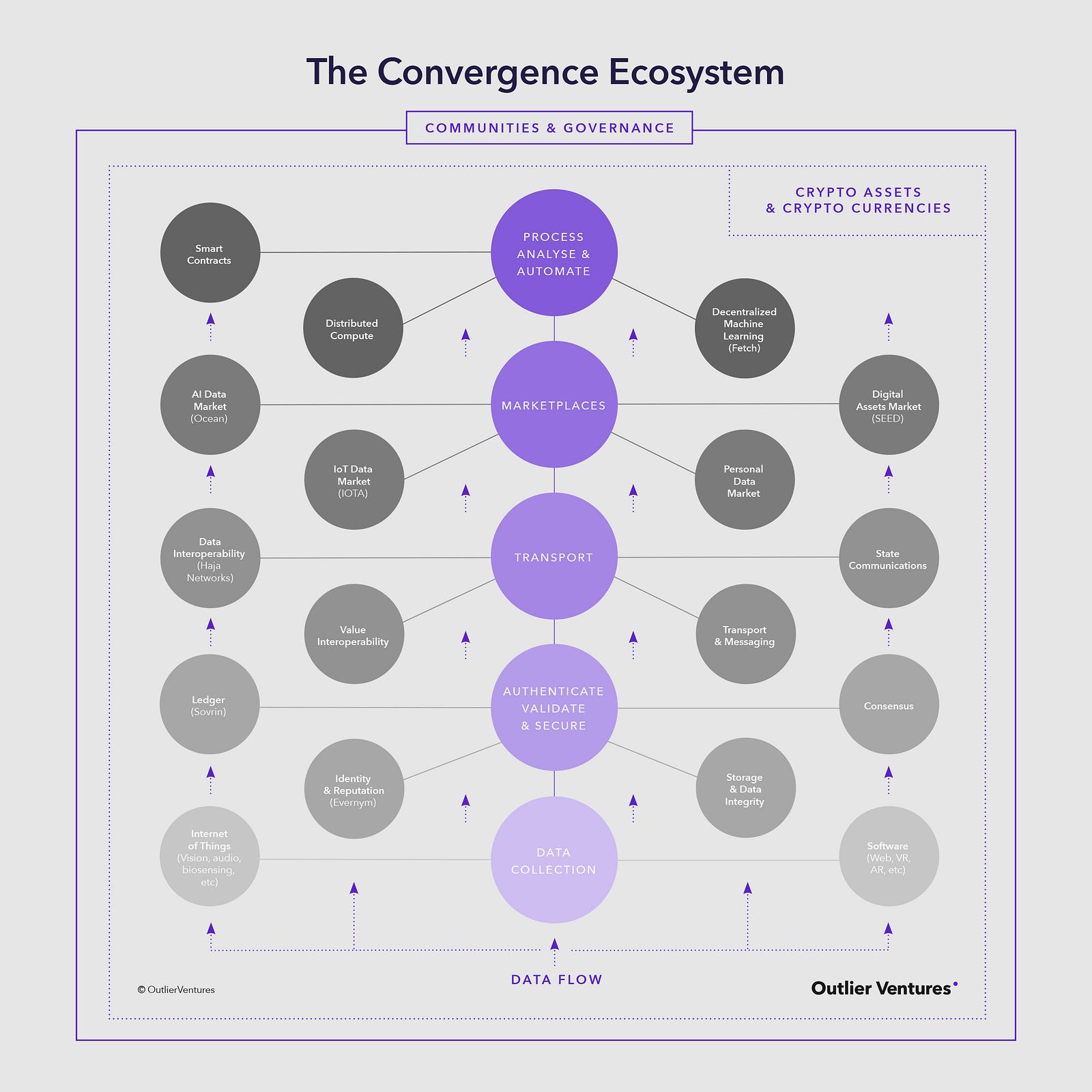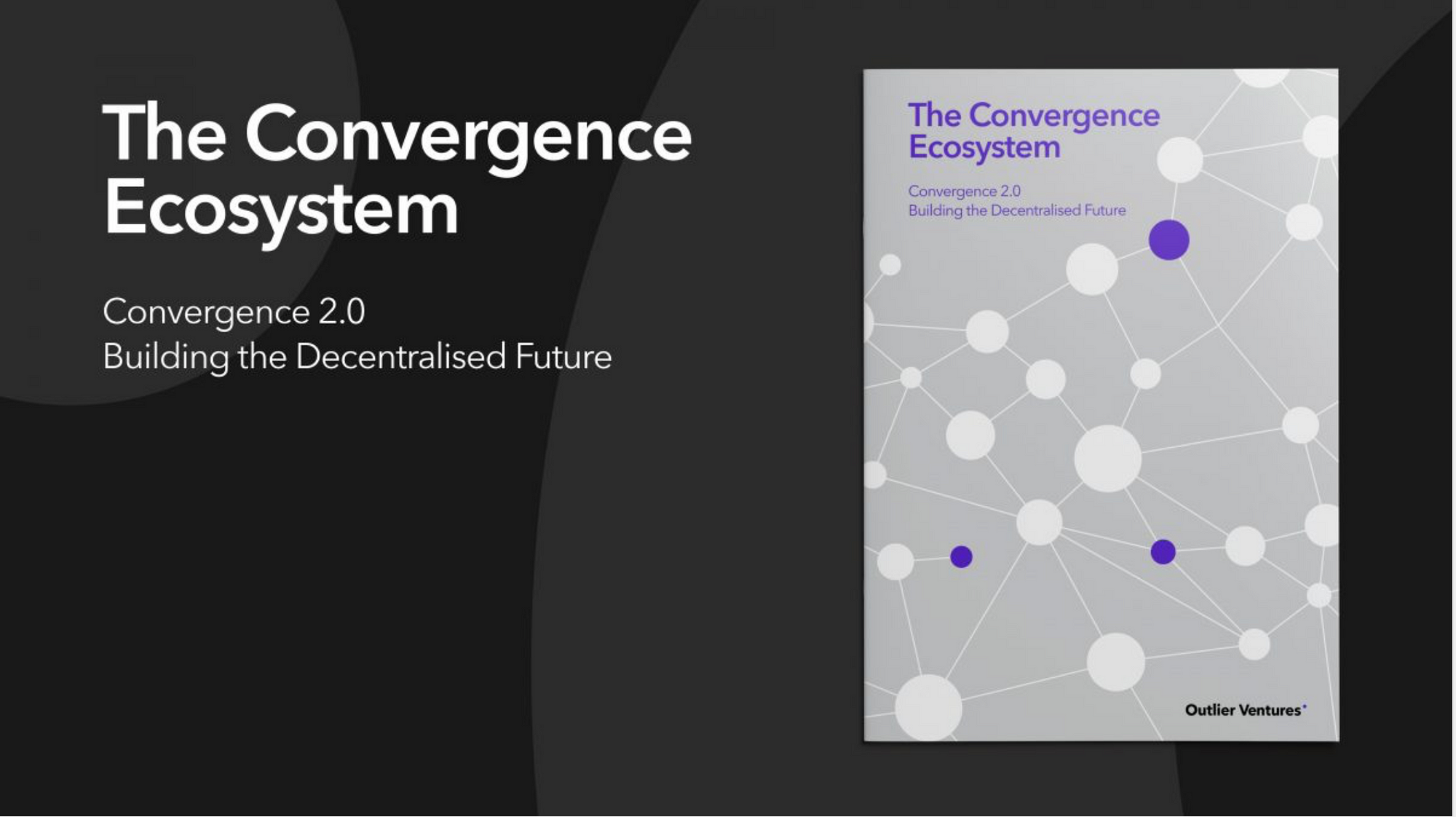Ready to learn Blockchain? Browse courses like Blockchain for Finance Professionals developed by industry thought leaders and Experfy in Harvard Innovation Lab.
The Ecosystem sees data captured by the Internet of Things, managed by blockchains, automated by artificial intelligence, and all incentivised using crypto-tokens. The Convergence Ecosystem is open-source, distributed, decentralised, automated and tokenised and we believe it is nothing less than an economic paradigm shift.
How We Got Here: The Outlier Journey
From Blockchain-enabled Convergence
In late 2016, we published a paper titled: ‘Blockchain-enabled Convergence’ outlining our investment strategy. The paper was the result of over three years’ experience researching, investing and building blockchain-based businesses. Our insight was that blockchains are not just a secure ledger for cryptocurrencies and other digital assets, but that they represented something more transformative: a decentralised data infrastructure. Infrastructure that could solve technical and market problems across a variety of emerging technologies like artificial intelligence, autonomous robotics, the Internet of Things, 3D printing and augmented and virtual reality.
In 2017, crypto-tokens proved they are the first digitally-native mass coordination mechanism
2017 saw a vast change in the cryptocurrency and blockchain markets to arguably the peak of inflated expectations as per the Gartner Hype Cycle. The ERC20 smart contract industrialised the token sale crowdfunding model, raising over 4 billion dollars in funding. Despite misplaced energy and too much focus on token prices, it is now clear, in a way that wasn’t in late 2016, that crypto-tokens are a critical missing component in decentralised networks — the first digitally-native mass coordination mechanism for humans, bots and machines. Recognising the underlying importance of crypto-tokens to create an ecosystem of converging technologies, we started investing.
From IOTA, Botanic & SEED, Evernym & Sovrin, to Fetch and Ocean
Over the last year we have partnered with and invested in IOTA, a foundation building Internet of Things infrastructure with a new type of decentralised data structure. Botanic and the SEED Vault foundation it founded, creating a platform for developers to publish trusted software bots. Evernym, a company using the Sovrin Network and Protocol to establish self-sovereign identity. Fetch, a startup building an emergent intelligence protocol combining distributed ledgers with machine learning. And most recently, Ocean Protocol, who are developing a decentralised data exchange protocol to unlock data for AI. Each of these investments have been strategically chosen because they are a complimentary piece of decentralised infrastructure required to create the Convergence Ecosystem.
Why We Need The Convergence Ecosystem
Centralised Web 2.0 has failed…
Centralised Web 2.0 digital infrastructure has failed. Too many hacks and data leaks. No individual privacy. Monopoly control over global information and communities networks. The Internet of Things is creating an unmanageable data environment, and artificial intelligence is giving those who control the most data more power than any company in history. As Tim-Berners Lee, the creator of the Web, recently wrote;
“What’s more, the fact that power is concentrated among so few companies has made it possible to weaponise the web at scale. In recent years, we’ve seen conspiracy theories trend on social media platforms, fake Twitter and Facebook accounts stoke social tensions, external actors interfere in elections, and criminals steal troves of personal data.”
Something must change.
We are 10 years into the decentralisation revolution
It has been ten years since the publication of Satoshi’s seminal paper and the introduction of the first viable decentralised solution to the problem of double-spend in digital networks. Bitcoin sparked interest and innovation in other cryptographic and decentralised technologies including blockchains and crypto-tokens. We are in a rapid period of experimentation around decentralised technologies including consensus mechanisms, identity, data structures, crypto-economic designs and smart contracts. Taken together, we see the foundations of a new data infrastructure.
Our Vision: The Convergence Ecosystem
Introducing the Convergence Ecosystem
We believe that future decentralised data infrastructure will come from the convergence of the Internet of Things (data production), blockchains (data distribution), and artificial intelligence (data consumption). The integration of these technologies will see markets become increasingly open-source, distributed, decentralised, automated, and tokenised.

The Convergence Ecosystem consists of four parts: governance, production, distribution and consumption. Each of these are explored in the paper, and we will be publishing further analysis into part throughout the year.
Governance — How are protocols and communities governed and incentivised?
- Data flow through the ecosystem is coordinated and incentivised using crypto-assets, crypto-currencies and crypto-consumables designed to incentivise behaviours for people, machines, devices and agents to the benefit of the overall ecosystem. These new types of assets will continue rapidly experimenting with supply and demand policy including fungibility mechanisms like the Ethereum ERC 721 NFTs.
- Emergent governance models will have differing levels of decentralisation and automation depending on the values of the community. Some will value censorship-resistance and others self-sovereign identity. New decentralised projects will be guided by social democratic values that prioritise wealth redistribution through ‘network’ (read: State) intervention or pre-agreed taxation rules. Others will prioritise ethical and environmental values with green-friendly policies that use non-consumption based consensus mechanisms (eg Chia) and focus on common-ownership and resource sharing. Communities will continue to experiment with traditional governance models like corporations and newer structures like decentralised organisations or decentralised autonomous organisations (DAOs).
Production — How is data produced?
- Data is brought into the ecosystem by either hardware connected to the Internet of Things or software such as digital, virtual or augmented spaces.
- We are creating and collecting more data than ever, but we are storing it in insecure private databases with no incentives to share the data. Data breaches and hacks are commonplace, and the data can be censored or tampered with. Software-generated data is lost, hoarded or latent. There is no reason for consumers to do anything other than to give data away for free and for corporations to hoard it. Decentralised infrastructure offers a solution.
Distribution — How is data authenticated, validated, secured and stored? How is it transported across databases and blockchains, and how is it exchanged?
- Once data is in the ecosystem it needs to be authenticated, validated and secured. This is where blockchains or more specifically distributed ledgers, consensus mechanisms, self-sovereign identity and reputation, and decentralised storage and data integrity solutions are valuable tools.
- Using new data distribution protocols such as; transport & messaging, state communication; value and data interoperability, data can be efficiently moved from storage across networks and protocols to marketplaces.
- Marketplaces are already developing going beyond just cryptocurrencies to support the buying and selling of all sorts of other data types including internet of things data, artificial intelligence data, personal data, and a range of newly emerging digital assets including but not limited to cryptokitties.
Consumption — How is data turned into insight?
- Finally, data is processed, analysed and automated using a range of technologies including distributed computation, decentralised machine learning and smart contracts.
- This is where data is transformed into actions and insight using traditional and distributed computing techniques, as well as newer types of computing such as quantum computing. It is at this layer where blockchains and artificial intelligence blur and it becomes clear they are intertwined and interconnected. Both smart contracts and machine learning offer differing levels of automation and decentralisation depending on the type of input data and level of trust the use case demands.
Winners will differentiate on values and trust
The open-source nature of the technology; ease of forking; almost zero costs of digital distribution; and interoperability protocols will mean projects will struggle to differentiate using technology in the long-term. Successful projects will differentiate through political values such as libertarianism, self-sovereignty and egalitarianism as well as through trust. This makes the Convergence Ecosystem structurally different from other markets in which value capture happens at friction points. With very few friction points and lock-in, we are unlikely to see the same market consolidation dynamic that has dominated previous digital markets. When technology and data are open and free, lock-in will come from brand and values. There will be as many protocols as there are value-systems and personal priorities.
There will not be one chain to rule them all. In a world of scarcity, competition is the optimal strategy. In a world of abundance, we must change our mental models. The Convergence Ecosystem drives collaboration rather than competition.
Outlier Ventures: VC for The Decentralised Future
The Convergence Ecosystem is our vision of the future. We expect the Ecosystem to support hundreds of communities that will over time outcompete their Web 2.0 competitors for developers and users using tokenised business models. This shift will not occur overnight. People will continue to focus on the price of crypto-assets and worry about the regulatory implications of public token sales.
But behind the scenes, a decentralised infrastructure is being built.
Network by network.
Protocol by protocol.
We want to invest and partner with tokenised communities to build decentralised economies. Join us to help build the decentralised future!
Download the full paper here
Also a big thanks to all the Outlier Ventures team including Joel John, Harry McLaverty and Shaquile Noir for their work on putting this together. Also to Jamie Burke, Aron van Ammers, Eden Dhaliwal, Anesu Machoko, and Geoff Le Fevre for their contributions and feedback.
Also a massive thank you to all of the people outside of Outlier that contributed to the paper:




